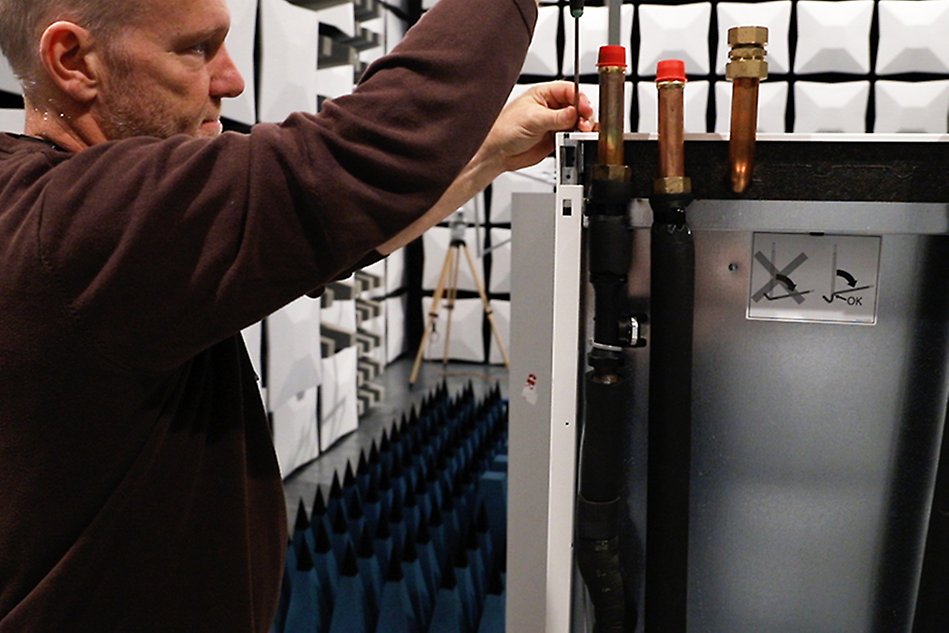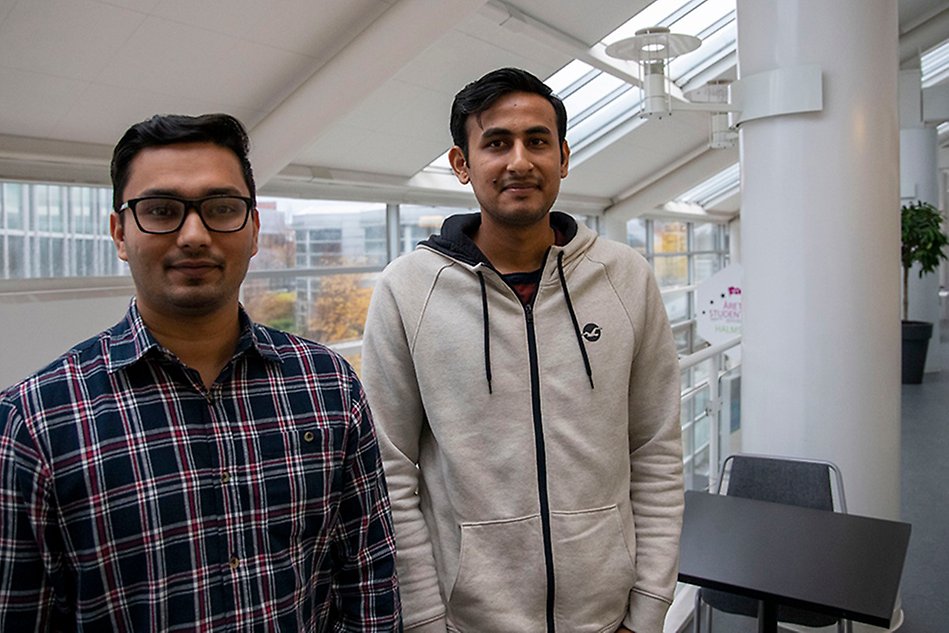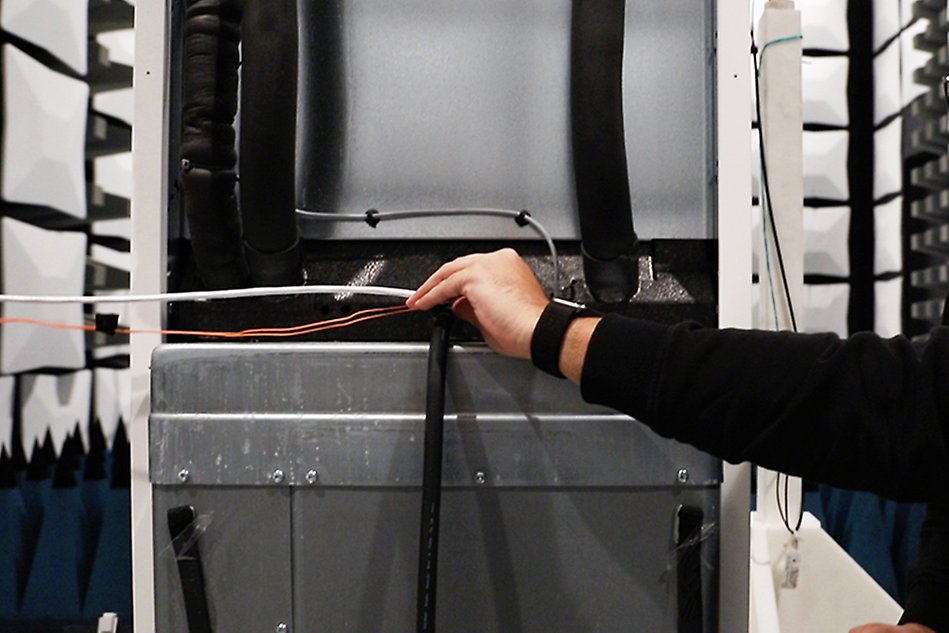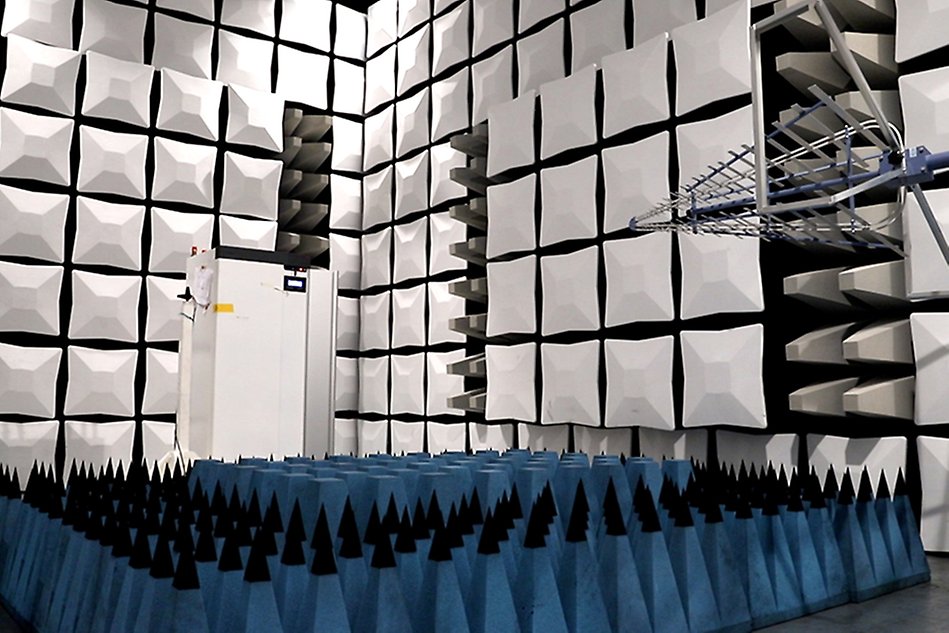Students create smart heat pump
It started as a project at the Swedish heating company NIBE and quickly became a collaboration between NIBE, Halmstad University and Electronics Centre in Halmstad (ECH). It soon developed into a Master’s thesis project and resulted in not only a new, smart product, but also two full time positions for the students at NIBE in Markaryd. The road has been long and had a few bumps, but in the end: a successful collaborative co-production resulting in a new, cost-effective antenna ready to go on the market.

”We realised we could take it one step further and combine one of the University’s labs, a company and students in the same project.”
Per-Olof Karlsson, Research Engineer
When NIBE decided that the heat pumps needed to be smart and able to connect to the smart home, they soon realised outside experts were needed.
“We have been working on this since 2013. It was an early decision to incorporate wireless communication into the heat pump. We started at the NIBE development department, but we did not have the experience. We have worked with different kinds of electronics, but never with radio technology, which is the kind of wireless communication needed in this project. Parallel to this, we had started building the Electronics Centre in Halmstad, that way we knew the competence was available”, says Per Fager, Electronic Engineer at NIBE.

Per Fager, Electronic Engineer at NIBE, working on the heat pump at ECH.
The competence Per Fager knew about was mainly that of Per-Olof Karlsson, Research Engineer at Halmstad University, with responsibility for Electronics Centre in Halmstad.
“Six months after I started working at the University in 2016 to be responsible for Electronics Centre in Halmstad, a collaboration started between NIBE and the University. For one year we did research on how to solve the technological aspects of increasing the robustness of the system. There was a lot of preparational work before we knew what the solution would be”, says Per-Olof Karlsson.
The solution was an antenna on the outside of the heat pumps, which worked, but was expensive. Heat pumps with that solution went on the market, while at the same time NIBE tried to develop a less expensive solution – that was when the Master’s thesis project was introduced.
A true collaboration
“The idea with ECH is to be a collaboration arena, to interact with companies and create synergy. With this project, we realised we could take it one step further and combine one of the University’s labs, a company and students in the same project.” says Per-Olof Karlsson.
There was no doubt that Divyaraj Gadhavi and Trushar Pansuriya would be the ones to take on the project as their Master’s thesis. They came to Sweden to study Electronics Design at Halmstad University and were looking for a project in the field when Per-Olof Karlsson helped them get on the right track. He introduced them to his office neighbour, Per Fager from NIBE, who has an office at the University to be close to the test facility in ECH.
In collaboration with ECH and NIBE, Divyaraj Gadhavi and Trushar Pansuriya started their Master’s thesis project to create a new, more cost-effective antenna with better performance for the heat pumps. The purpose of the antenna was to improve the communication system of the heat pump without disrupting its functions. The circuit board was already in place in the heat pump, making wiring the antenna through it convenient and cost-effective. Coming up with a tangible solution was a true collaboration between all parties.

Divyaraj Gadhavi and Trushar Pansuriya came to Sweden to study Electronics Design at Halmstad University.
“The best part of the project was when we discussed our solution with Per Fager and Per-Olof Karlsson. Those meetings were really interesting. There were so many ideas; we got creative and used the whiteboard for all the equations to get a result. We had weekly meetings where we shared what we had done during the week and they gave us feedback and input on factors that needed to be considered. We had interesting discussions and we learned something new every time, things that still help us”, says Trushar Pansuriya.
“Tough to find the balance”
Both students describe optimising the antenna for the heat pump as challenging, and it took a lot of preparational work to succeed. They learned three different software systems, designed five different antennas and had to always take into consideration the size of the heat pump and its content.
“The position and available space in the heat pump is fixed, so we had to design our antenna according to that space. The antenna may look small but to design it properly was a big challenge”, says Divyaraj Gadhavi.
Trushar Pansuriya agrees and continues:
“In this time of IoT (Internet of Things), everyone offers mobile connectivity with wifi, so everything that has wifi needs an antenna. But when you work with products that have many different electrical components and a shell that effects, like in the case with the heat pump, it can merge poorly with the antenna. It requires a specific placement and connection so that it does not interfere with other functions of the product”, says Trushar Pansuriya.
The technical factors were the main challenge in this project, but the time aspect and how different it was for NIBE and the University was also a bit of a challenge. Per Fager describes it as the companies planning their work for the coming weeks, while thesis projects take months.
“It is tough to find the balance. The companies work at a different pace than we do. We have three-month intervals and they work at a whole other speed”, says Per-Olof Karlsson.
However, this did not affect the outcome of the project, since NIBE encouraged Divyaraj Gadhavi and Trushar Pansuriya to finish the antenna, while working at their own pace, as there was a great need for it.

The heat pump with the new antenna is expected to be on the market at the beginning of 2020.
From strategy to reality
Divyaraj Gadhavi and Trushar Pansuriya worked on the antenna and its design for several months before finding a solution. The Master’s thesis project was by then finished, but the work with the antenna and the heat pump was not.
“When we got this project, the first challenge was to design an antenna and the main focus was on that only. After we finished the project, we got an internship at NIBE to work further on this product and we had to figure out how things were going to work in the real world”, says Divyaraj Gadhavi.
The internship was part of a project that took place at Halmstad University and was led by Pererik Andreasson, Senior Lecturer at Halmstad University.
“It was great to be a part of Divyaraj and Trushar’s journey from Master’s thesis project to them getting employment at NIBE. We have all learned a lot by directly collaborating with the company and ECH, all made possible by funding from the Knowledge Foundation*”, says Pererik Andreasson.
”We are applying our design into the actual product, and that is a big achievement for us.”
Divyaraj Gadhavi
After their internships, both Divyaraj Gadhavi and Trushar Pansuriya were hired by NIBE to, among other things, continue working on the antenna to improve it even more, test it at ECH and incorporate it into the heat pump. They now come to the Electronics Centre in Halmstad at least once a week to continue their work. The heat pump with the new solution is expected to be on the market at the beginning of 2020.
“We are applying our design into the actual product, and that is a big achievement for us.” says Divyaraj Gadhavi.
The collaboration arena ECH creates mutual benefit
The heat pump is expected to live for 10 to 12 years with the solution the students developed. Both Per-Olof Karlsson and Per Fager think the collaboration turned out great and that similar collaborations will continue to take place in the future. Per-Olof Karlsson bases the success of this project on straightforward communication between all parties. Large projects, like this one, are quite rare but small projects in collaboration between ECH, NIBE and Halmstad University students are more common.
“Projects between the University and businesses are constantly ongoing. The businesses have offices here with us and we have continuous dialogues. The vision for ECH is to be able to transfer our expertise to the businesses and gain a lot of knowledge from them about what it is like in the real world. If it is possible to combine those, it benefits us a lot when it comes to education, since we can stay up to date on what kinds of engineers are actually needed on the market. That way, we are not stuck using models that are not really relevant anymore”, says Per-Olof Karlsson.

Electronics Centre in Halmstad, where the heat pump and its new antenna is tested.
Pride and gratitude are two emotions Divyaraj Gadhavi and Trushar Pansuriya feel at this point. Pride, because their design was successful, and gratitude because of all the help they received from various people along the way.
“During this project, we got a lot of really good feedback and had a lot of good discussions that taught us a lot. They were happy to give us their knowledge and provided all the tools we needed. Apart from Per and Per-Olof we also got great support from our professors: Emil Nilsson, Johan Malm and Pererik Andreasson”, says Trushar Pansuriya.
Divyaraj Gadhavi agrees and continues:
“NIBE has also been very helpful letting us do the project, giving us the internship and then the employment. We are very grateful towards NIBE, especially towards Mattias Nilsson, Product Development Manager, and Per Fager, for giving us this opportunity”.
A part of Sweden
Neither Divyaraj Gadhavi nor Trushar Pansuriya are sure if they want to stay in Sweden for ever, but so far, they like it.
“I really admire the Swedish people and so far our time in Sweden has been amazing”, says Divyaraj Gadhavi and Trushar Pansuriya continues:
“I think Swedish people are really nice and I tell people back home in India that we have not faced any kind of situation here that has made us feel distanced from society. Everyone is helpful and tries to speak English and I appreciate that”, says Trushar Pansuriya.
Text: Linnéa Andersson
Photo: Ida Fridvall and Linnéa Andersson
Footnote. The project eMC-Hammer is well in line with the University’s profile area Smart Cities and Communities.
* The Knowledge Foundation funds the University’s research environment Research for Innovation.
Read more
Electronics Centre in Halmstad
School of Information Technology
Master's Programme in Electronics Design
Läs artikeln på svenska: Studenter skapar smart värmepump External link.

